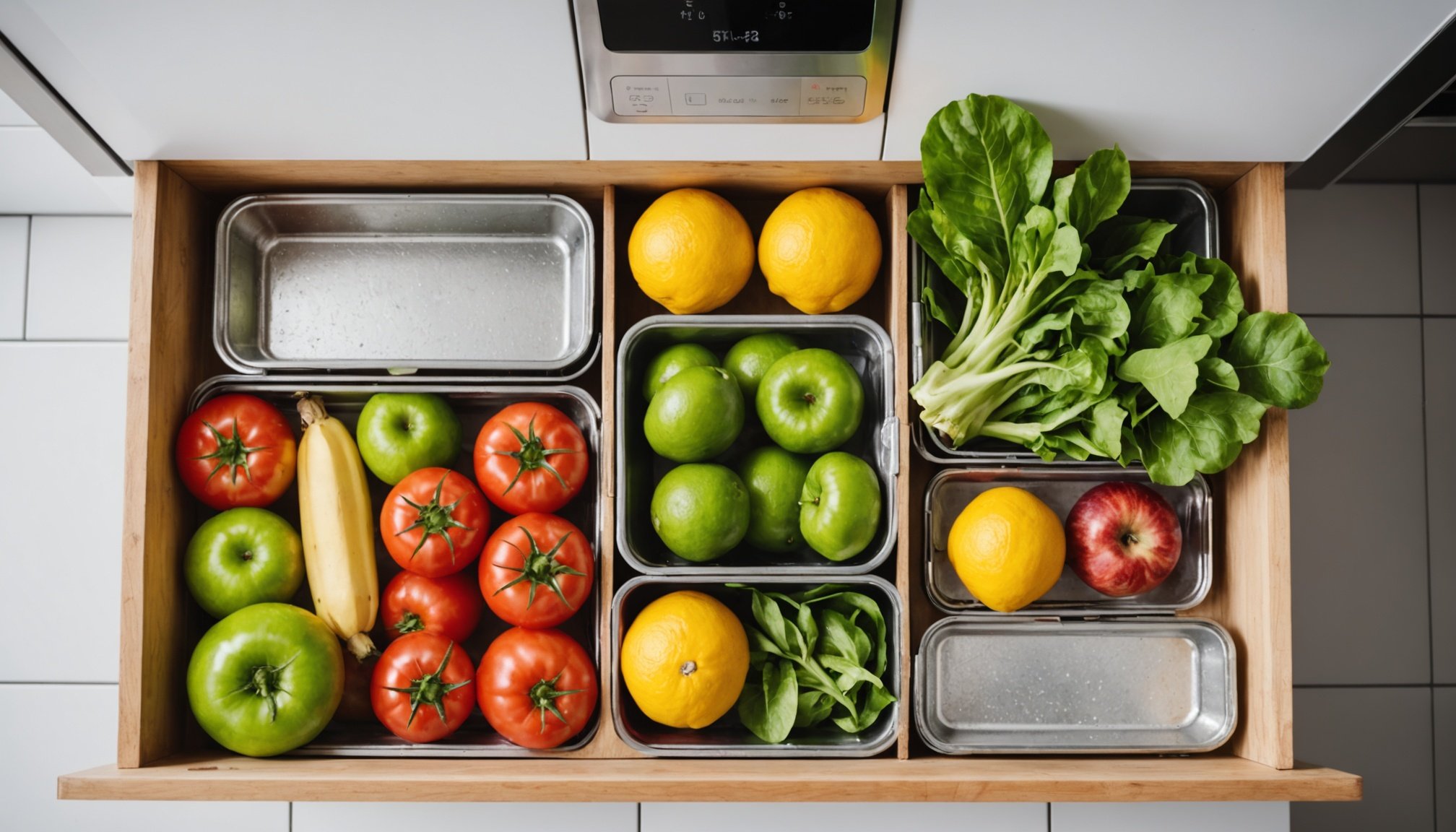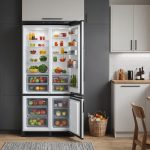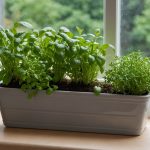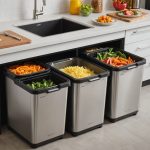Transform Your UK Kitchen: Eco-Friendly Designs to Reduce Food Waste Effectively
In the heart of your home, the kitchen is not just a place for cooking, but also a space where you can make a significant impact on the environment. By incorporating eco-friendly designs and practices, you can transform your UK kitchen into a sustainable hub that reduces food waste, conserves energy, and promotes a healthier planet. Here’s a comprehensive guide to help you achieve this goal.
Why Eco-Friendly Kitchens Matter
Eco-friendly kitchens are more than just a trend; they are a necessity in today’s world. Food waste, in particular, is a significant issue that affects both your wallet and the environment. According to the EPA, food waste is the single largest contributor to landfill content, where it releases methane, a potent greenhouse gas[1].
Also read : Designing a dreamy breakfast nook: chic inspirations for your ideal uk kitchen
Environmental Impact
- Carbon Footprint: Reducing food waste directly impacts your carbon footprint. By composting food scraps, you divert waste from landfills and create nutrient-rich soil instead.
- Water Conservation: Growing your own food using composted soil can reduce the need for chemical fertilizers and irrigation, conserving water resources.
- Energy Efficiency: Eco-friendly kitchen appliances and design elements can significantly reduce energy consumption, making your kitchen more efficient.
Economic Benefits
- Save Money: Using leftovers creatively and composting food scraps can extend the life of your groceries, reducing the need for frequent shopping trips.
- Long-Term Savings: Investing in energy-efficient appliances and sustainable materials can lead to long-term savings on utility bills and maintenance costs.
Effective Storage Solutions for Food Scraps
Before diving into the broader aspects of an eco-friendly kitchen, let’s start with the basics: storing food scraps.
Countertop Bins
- Compact and Odor-Free: Countertop bins are ideal for small kitchens. Look for bins with charcoal filters to trap odors and keep your kitchen fresh[1].
- Example: Stainless steel bins are durable, easy to clean, and often come with odor-controlling filters.
Freezer Bags or Containers
- Convenient and Odor-Free: Freezing food scraps is a great option, especially if you don’t empty your compost bin frequently. This prevents odors and slows down decomposition[1].
- Tip: Use airtight containers or freezer bags to store scraps in the freezer until you’re ready to compost them.
Under-Sink Containers
- Out of Sight, Yet Accessible: Under-sink containers are perfect for those who prefer not to have scraps on the counter. Choose one with a lid to prevent smells from lingering[1].
Custom Pull-out Compost Bin
- Functional and Stylish: A pull-out compost and recycle center can be integrated into your kitchen cabinets, offering easy access without compromising the kitchen’s aesthetic[1].
Eco-Friendly Kitchen Products
Choosing the right products can significantly enhance your kitchen’s sustainability.
In parallel : Ultimate guide to choosing the ideal refrigerator size for your expanding family in the uk
Eco-Friendly Materials
- Sustainable Serveware: Opt for serveware made from sustainable materials like FSC-certified wood or bamboo. For example, a serving board made from FSC-certified European Ash Wood is both elegant and eco-friendly[2].
- Bamboo or Wood Bins: Bamboo or wood bins are sturdy, eco-friendly, and often lined for easy cleaning[1].
Energy-Efficient Appliances
- Smart Composters: The Vego Kitchen Composter is an excellent example of an energy-efficient appliance. It offers multi-mode options, is odor-free, and has smart features that make composting easy and efficient[4].
- Energy-Star Rated Appliances: Look for kitchen appliances with the Energy Star rating, which indicates they meet energy efficiency standards set by the U.S. Environmental Protection Agency.
Creative Use of Leftovers
Reducing food waste also involves using leftovers creatively.
Plan Ahead
- Meal Planning: Plan your meals in advance to avoid buying excess food. Use a serving size calculator to estimate the right amount of food for your needs[5].
- Example: When cooking, think about how you can repurpose leftovers. For instance, leftover roasted vegetables can be added to a fresh salad or used in a hearty soup.
Store Properly
- Airtight Containers: Store leftovers in airtight containers and label them with the date. Perishables should be stored in the refrigerator, and items that won’t be used within a few days should be frozen[3].
- Tip: Before grocery shopping, check your fridge and pantry to see what needs to be used up. Plan meals around those ingredients.
Mix and Match
- Versatile Dishes: Combine leftovers with fresh ingredients to create new dishes. For example, yesterday’s rice can be turned into a flavorful fried rice with additional vegetables and protein[3].
- Examples of Dishes:
- Soups and Stews: Use leftover meats, vegetables, and grains to make hearty soups and stews.
- Frittatas and Omelets: Mix leftover vegetables, meats, and cheeses into a frittata or omelet for a quick and nutritious breakfast or lunch.
- Stir-Fries: Toss leftover meats, vegetables, and rice or noodles in a hot pan with some soy sauce, garlic, and ginger for a delicious and easy meal.
Sustainable Kitchen Design
A sustainable kitchen design goes beyond just the products you use; it involves the overall layout and materials of your kitchen.
Sustainable Materials
- Eco-Friendly Countertops: Choose countertops made from sustainable materials like recycled glass, bamboo, or reclaimed wood.
- Energy-Efficient Lighting: Install LED lighting, which is more energy-efficient and lasts longer than traditional lighting options.
Built-In Compost and Recycling Stations
- Slide-Out Drawers: Integrate slide-out drawers for compost, recycling, and general waste near your prep areas. This makes it easy to sort food scraps and recyclables as you cook[1].
- Dual-Bin Compartments: Use built-in stations with separate, labeled compartments for composting and recycling to keep everything organized and odor-free[1].
Practical Tips for Reducing Food Waste
Here are some practical tips to help you reduce food waste in your kitchen:
Shop Smart
- Detailed Shopping List: Create a detailed shopping list to avoid impulse buys and ensure you only purchase what you need. Review your pantry before shopping to prevent buying duplicates[5].
- Portion Control: Plan your servings based on the number of guests you’re expecting. Overestimating can lead to leftovers that often end up in the trash.
Use What You Have
- Check Your Fridge and Pantry: Before grocery shopping, check what needs to be used up. Plan meals around those ingredients to reduce waste[3].
Table: Comparing Eco-Friendly Kitchen Products
| Product | Material | Features | Benefits |
|---|---|---|---|
| Vego Kitchen Composter | Advanced Composting Technology | Odor-free, self-cleaning, multi-mode options | Reduces waste by 85-95%, efficient, and convenient[4] |
| Stainless Steel Bin | Stainless Steel | Durable, easy to clean, charcoal filter | Odor-free, compact, and practical for small spaces[1] |
| Bamboo Serving Board | FSC-certified Bamboo | Natural, food-safe finish, handcrafted | Sustainable, elegant, and durable[2] |
| Recycled Bamboo Mixing Bowl | BPA-free, PVC-free bamboo fiber composite | Dishwasher-safe, versatile design | Eco-friendly, durable, and easy to clean[2] |
| Energy-Star Rated Appliances | Various | Energy-efficient, meets EPA standards | Reduces energy consumption, long-term savings |
Quotes from Experts and Users
- “Composting food scraps not only reduces household waste but also brings numerous environmental benefits. By composting, you help divert food scraps from landfills, turning waste into valuable soil nutrients instead.”[1]
- “The Vego Kitchen Composter is the best overall and our top pick, offering multi-mode options, sleek design, smart features, and odor-free operation, reducing kitchen waste by 85–95% efficiency.”[4]
- “Using leftovers creatively can be a fun and creative culinary challenge, inspiring you to experiment with flavors and cooking techniques.”[3]
Transforming your UK kitchen into an eco-friendly space is a journey that involves small but significant changes. From choosing the right storage solutions for food scraps to using leftovers creatively, and from selecting sustainable materials to designing an efficient kitchen layout, every step counts.
By making these changes, you not only reduce your environmental impact but also create a kitchen that is efficient, friendly, and sustainable. Here are some final tips to keep in mind:
- Make Your Kitchen Efficient: Invest in energy-efficient appliances and lighting to reduce your carbon footprint.
- Use Friendly Materials: Opt for sustainable materials in your kitchen design, such as recycled glass or bamboo.
- Reduce Food Waste: Plan your meals, store leftovers properly, and use them creatively to minimize waste.
- Create a Sustainable Design: Integrate built-in compost and recycling stations to streamline your waste management.
By following these guidelines, you can create a kitchen that is not just a place to cook, but a hub of sustainability and eco-friendliness, making a positive impact on your home and the environment.











